Minibus Madness (part 2)
SUMBAWA BESAR TO BIMA
FEBRUARY 22
My morning breakfast of toast and Pepto-Bismol braced me for flagging down a public bemo bound for the bus terminal. It was filled with young men, who were all bus agents (a/k/a touts) on their way to work. They took a personal interest in my welfare and one even carried my pack (for free) from the bemo to the waiting minibuses.
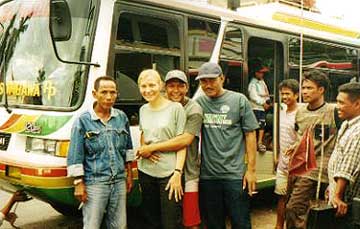
Bus touts cop a feel
A heated discussion ensued over which bus to put me on, and finally the touts decided that "Merri" should ride in the front seat of the newest bus on the lot. I paid 25,000 rupiah, or $2.66, for the seven hour bus ride. I didn't bother to negotiate. The price seemed reasonable and they were treating me like a princess.
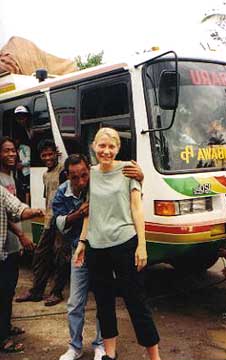
Piro sat between me and the driver for the whole trip. He was Javanese, afraid of dogs, and had worked in computer graphics, public relations, and as a Hyatt bartender in Guam. He was currently selling medicinal herbs throughout Indonesia. Piro was a good seatmate, and explained the intricacies of Sumbawanese society as we drove through the villages.
"This is a wealthy area," he said. "You can tell because they own many buffalo. Ten buffalo can pay for a trip to Mecca."
I had decided the area's residents were wealthy too, but by a more mundane standard. I had been counting the numerous satellite dishes adorning the tiny rooftops.

Goats have to travel too
The road was paved, but still too narrow for the minibuses, trucks, motorbikes, goats, dogs, and horse-drawn carriages that plied the route. Sumbawa turned out to be beautiful, with stunning views of mountains and clouds. The road hugged the coast, twisting its way through the hills.
The trip seemed to take forever, as the driver stopped for anyone who flagged him down. Long after the bus was packed, he continued to stop for more passengers. Those who didn't fit went on the root. A tape of popular Indonesia tunes looped over and over through the cassette player. I was glad for my seat of honor.

Sumbawa traffic jam
The refrain "hellomissus" (or sometimes "hellomister") came through my open window any time we passed a child, or even some adult men. My guidebook even had a section on this:
"Hello Mister is the universal greeting given to foreigners regardless of whether the person being addressed is male or female. The less advanced English students know only 'Mister,' which they will enthusiastically scream in your ear every five seconds."
No one tried to sell me trinkets-- tourists didn't come to Sumbawa, and there was no market for souvenirs.
My plan had been to go to Sape to catch the morning ferry, but a Czech couple had told me with great certainty that the ferry did not run on Friday. I decided to stop in Bima and hole up at the nicest hotel in town. Hotel Lawata, according to Lonely Planet, was luxurious, on the sea, and had a swimming pool. The bus driver had seen the sign before-- he knew where it was. He dropped me off at the hotel's driveway, and I walked to reception.
Some men sat in the abandoned reception area. The hotel was a deserted shell.
I collapsed into a chair. "What has happened to the hotel?" I asked, motioning around me.
"Bankrupt," said one. "Three years now."
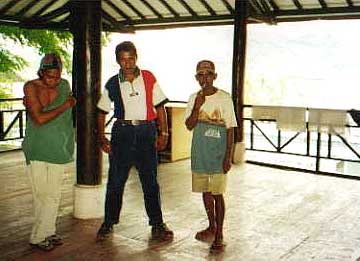
Bima men at bankrupt hotel
They took me on a tour of the grounds. It had been a lovely hotel, with smart bungalows set up in the cliffs. The oldest man had accompanied me, and he sent the three youngest boys with me when I walked back to the main road. He barked some instructions at them in Indonesian-- presumably something like "get her safely into a bemo bound for Hotel L'ambitu."
No bemos came by, so they hailed a horse-drawn carriage. Two local kids, spotting me and knowing good fun when they saw it, hopped in with me to go along for the ride.
We trotted back to town, while the kids giggled and screamed at their passing friends. I said goodbye, promised to send them postcards, and checked into Hotel L'ambitu.
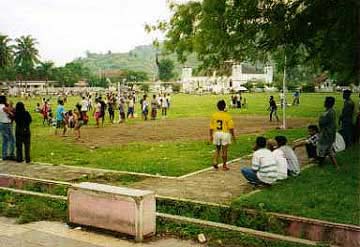
Fun in Bima
Bima was nothing special. It was small and dusty, with low cement buildings. The Hotel L'ambitu, while far from spectacular, was newish and had a helpful staff. The manager offered to call to Sape to check on the ferries to Flores for me.
I ran into three other tourists in a restaurant down the street. They told me horror stories of trying to catch the Flores ferry.
There had been a tropical depression all week, and the ferry schedules were screwed up. No ferry had run in days. One guy had gotten up at 4 a.m. to catch the 8 a.m. ferry, and when he'd gotten to the terminal he'd learned there was no 8 a.m. ferry. People were camped out in the terminal, hoping that a ferry would leave someday soon.
All three were giving up on their Komodo dreams-- they'd have to settle for photos of Komodo dragons. They headed back to Bali on the evening bus.
Back at the L'ambitu, the manager assured me that there was a Friday ferry. He had called, and it was leaving at four in the afternoon. He advised me to go to the terminal early, in case plans were altered at the last minute. I agreed.
BIMA TO LABUANBAJO, FLORES
FEBRUARY 23
My laundry, rinsed out in the sink the night before, was still damp. I went to the hotel manager, who was getting tired of assuring me that the ferry left at four.
"Do you have a clothes dryer?" I asked.
"Of course." He called the laundry man, who disappeared with my clothes.
Twenty minutes later, I went in search of them. Were they dry yet? A taxi driver friend of the manager's took me to the laundry man's office.
The dryer was the tin roof! My clothes were neatly spread out in the sun. And they were totally dry.
The taxi driver watched me tip the laundry man, and then ushered me out of the hotel. He tried a few times to get me to take his taxi, but I refused, wanting to take public transport. He then flagged down his friend's bemo and sent me towards the bus terminal.
Ten minutes later, the bemo pulled over. Another bemo was nearby, its driver yelling "Sapesapesape" at the passing cars.
"Sape," said my driver. He motioned to me to switch bemos. So I did.
The new bemo took me all the way up the hills, over the winding road for an hour and a half to Sape. It wasn't comfortable-- bemos never are. I was the fourteenth passenger in the tiny yellow minibus, and was crushed in between an old Muslim man (in a lilac shirt and purple sarong) and a 20-something year old guy in a baseball cap. In addition to my pack, we were sitting on top of metal rods, two bags of rice, and a box of old clothes. Only about a third of my butt actually was on the bench, the rest of me being held in place by other sweating bodies.
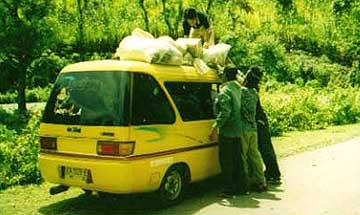
14-person bemo from Bima to Sape
We finally got to the town, drove to the center, and everyone got out.
"Pelubuhan," said the driver, motioning ahead. Pelubuhan meant port, or something like that. I knew he was telling me the ferry was up ahead. He then pointed to a horse-drawn carriage.
"Ben Hur," he said. That's what the locals called them. He held up one finger. I understood-- I should take the horse, and pay one thousand rupiah. I thanked him profusely and hailed a Ben Hur.
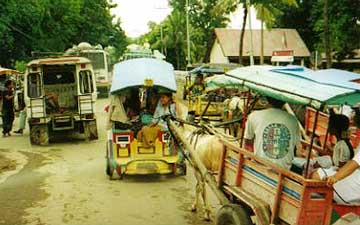
"Ben-Hur"
The Ben Hur driver was about thirteen. The other passengers looked at me and smiled-- a dad was escorting his little girl (stuffed with chocolate) to school, and a woman was going to market with a tub of fish. It was about noon when the Ben Hur left me at the ferry terminal.
"When does the ferry leave?" I asked.
"Four." I loved the Hotel L'ambitu.
"When can I buy a ticket?"
Three fingers. I felt bad for the travelers who had turned back.
I found a little food stall and sat down to have a Coke, to make up for the horrific coffee the L'ambitu had served me. I was immediately surrounded by curious Sumbawans.
The good thing about untouristed areas is that prices are low and the locals are excited to talk to foreigners. The bad thing is that it is impossible to sit alone.
For an hour, a young man conversed with me. Others who could not understand our talk just crowded around and stared. Finally, exhausted, I made excuses and fled to a pack of foreigners up the road.
The five Europeans had all been waiting for the ferry to leave since early in the morning. Two of them were the Czechs who had reported their ferry information to me with great authority back on the bus-- they had been quoting to me from their Lonely Planet guidebook-- the same one I was using. Only I had the sense to read the disclaimer: "Things change - prices go up, schedules change, good places go bad and bad places go bankrupt - nothing stays the same." I made a mental note to ignore the Czechs advice in the future.
We all boarded the ferry together for the seven hour ride to Flores. I was careful to stick with the Europeans-- every time I strayed, my pal the Indonesian came over to practice more English. Finally, I loaned him my guidebook to distract him. He and his friends studied it for four hours. They were from Indonesia, but had never bothered to read up on the nearby islands.
When he returned the book, he asked me a disturbing question.
"May I ask you a personal question when we get to Labuanbajo?"
I was evasive, concerned about the question. I returned to the safety of foreigners.
Two Irish guys had joined us, and they stood with me at the rail. We looked out at the Flores night as the ferry docked. Dozens of men were on the pier, literally hopping with excitement as we approached. They leapt the last three feet to the ship-- we were boarded.
That was our signal to shoulder our packs and get out quickly, before anyone could try to carry our bags or divert us to their choice of hotels. We bolted to the main road through town and started walked.
We lost the Irish guys to the Felix Homestay, and the rest of us checked out the Bojo Beach Hotel. It was nothing special. $3.13 for a dirty old room with a shower and ceiling fan. It was after 11 p.m. and I didn't want to wander around all night looking for a place to stay, so I checked in. The others said that the Bojo Beach was too pricey and wandered down the road.
I went out to find some food, and my Indonesian friend from the ferry walked by.
"May I ask you the personal question now?" he said.
"Okay," I steeled myself.
"Can I have your Billabong t-shirt?"
I laughed, and told him that I did not own a Billabong t-shirt, just a new Billabong bikini that would not fit him. He looked disappointed. He had assumed that all foreigners had Billabong t-shirts.
LABUANBAJO
FEBRUARY 24
Early in the morning, I canvassed the local tour operators. How could I get to Komodo?
I was hoping for a four day/three night sailboat journey back to Lombok, by way of Komodo. Every travel agent had a sign advertising one, but the next one left on March 1.
Five days in Flores was too much. There were three brightly colored lakes that I wouldn't mind viewing-- I'd been seeing them on the 5000 rupiah note for some time. But it would take 14 hours there and 14 hours back on a minibus, and I'd have to get up at three a.m. to see them. I'd spotted two from the plane from Dili, and wasn't sure I was three days worth of committed to the lakes.
There was nothing to do for the other two days. Labuanbajo was a tiny town, possibly okay for beach-lovers, but even they would be bored quickly.

The lakes of Flores, on the 5000 rupiah note
I changed my approach. Were there any one or two day tours to Komodo?
Sure, if I could round up some other tourists to go alone. My other option was to charter a boat just for myself.
Martin, one of the Czechs, then rounded me up. The five foreigners from the ferry and the two Irish guys were going to charter a boat to Rinca-- Lonely Planet said it had better dragon-spotting than Komodo. I agreed. We went back to the Bojo Beach to meet the others-- three of them had checked in there after wandering around for an hour last night.
It was 150,000 rupiah ($15 or so) to charter a boat for the 5-8 hour trip. Martin swore by his Lonely Planet, which stated the rate was 100,000 rupiah, and he negotiated a boat owner down. Split between eight people, we were arguing over a difference of $1.33 each. The more expensive boat was bigger, faster, and semi-luxurious, but we took the ratty, wooden, lifevest-free motorboat, complete with cockroaches. We were seriously going local.
As we motored towards Rinca, the others had a bitch session about feeling ripped off all of the time. They'd all been traveling longer than me, and some of them were traveling on Czech or Dutch money, worth a good deal less than my U.S. dollars.
"Everyone on Lombok is a liar," declared one of my new friends. He'd been sold a ticket for a through bus and ferry, for a non-existent route. The others had purchased tickets for a "fast boat" to Flores. There was no such thing, and in fact, there had barely even been a slow boat.
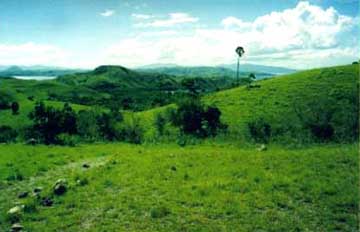
Rinca
I slept most of the way to Rinca, occasionally opening my eyes to see pointy islets of green jutting out of the turquoise sea. The boat dropped anchor off of Rinca. 20 Indonesian men lie napping on the shady port, and one three-foot long Komodo dragon was napping on the bank below.
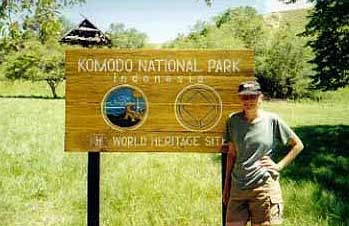
Entrance ticket to Komodo National Park
We all got excited, pulled out our cameras, and just about ran to the Visitor's Center. This was what we'd come for!
"Look, monkey," said Martin, pointing. And then we saw another, and another.

"Look, dragon!" A Komodo dragon was headed right for us, marching quickly. He couldn't be bothered with us and walked right by. His legs moved like they were on pivots, and looked strong and flexible. Apparently, the dragons can sprint short distances, and this particular dragon was trucking.
We paid our admission at the Visitor's Center. Martin forced the Park Ranger to show us an official list of fees as the asking price didn't agree with the Lonely Planet price. A guide with a big stick led us down a path to where two six-foot dragons were resting under a cabin on stilts. There was a third on a nearby hill, and another about fifty yards away. The guide threw some large rocks into a clearing-- dragon bait.

The dragons, lackadaisical on our approach, sprang into action. All four jumped up and ran towards the rocks-- and us.
"Quickly, quickly," urged the guide, sheparding us up the stairs of the stilt cabin. We bolted.
The guide, meanwhile, scampered away to a safe distance. The dragons congregated just under us excited tourists (cameras flashing). One dragon moved towards the stairs.
"He's going to climb up," shrieked someone.
He didn't. He waited patiently. He had us up a tree.

Then, there was another loud thud. The guide tossed a few more rocks. The dragons followed the sound, moving away from us. We watched them, with their five toes on each foot, holes instead of ears, and long tails that could be used as weapons.
We got out while the getting was good, and followed the guide on an hour-long hike through the forest.

Our walk garnered us one more dragon, lots of sunburn, and some sweat. We were all happy to sit back down on the boat, and were even happier when we stopped over a reef for some snorkelling.

Entrance ticket to Komodo National Park
Afterwards, I sat on the front of the boat with Ray the Irish radiologist. It had gotten dark, and we could see the lights of Labuanbajo in the distance. Ray and I were unsuccessfully trying to pick out constellations.
"This is what it's all about, isn't it?" I asked dreamily. "The buses, the ferries, the inconveniences... all for moments like this one."
Behind us, the Czechs threw a cockroach into the sea.
NEXT: Trust me, planes are better.